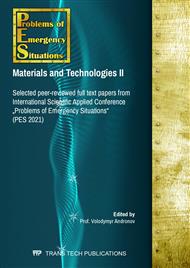[1]
G. V. Sakash, A. F. Kolova, T. Ya. Pazenko, Ochistka stochnykh vod po pererabotke moloka, Vestnik KrasGAU, 8 (2016) 97–103.
Google Scholar
[2]
T. A. Shevchenko, A. A. Shevchenko, Eksperimentalnoie issledovaniie intensifikatsii protsessa napornoi flotatsii pri ochistke stochnykh vod molokopererabatyvaiushchego predpriiatiia, Vostocho-Yevropeiskii zhurnal peredovykh tekhnologii, 1/6 (79) (2015) 4–12.
Google Scholar
[3]
V. A. Andronov, Ye. O. Makarov, Yu. M. Danchenko, T.M. Obizhenko, Research of the regularities of forming and chemical composition of sewage water of a dairy processing company, Technogenic and ecological safety, 7 (1/2020) 13–21.
Google Scholar
[4]
Ye.O. Makarov, Ekolohichna nebezpeka vysokokontsentrovanykh stichnykh vod molokopererobnykh pidpryiemstv. Stalyi rozvytok – stan ta perspektyvy: Materialy II Mizhnarodnoho sympoziumu SDEV'2020, Lviv, (2020) 235–236.
Google Scholar
[5]
M. Konevych, V. Hud, Osoblyvosti stichnykh vod molokozavodiv. Materialy XV naukovoy konferentsii TNTU imeni Ivana Puliuia, Ternopil, (2011) 309.
Google Scholar
[6]
S.B. Zuieva, I.N. Matiushchenko, E.O. Nozdrina, Osobennosti koaguliatsionnoy ochistki stochnykh vod molochnoy promyshlennosti s ispolzovaniiem filtratsionnogo osadka sveklosakharnogo proizvodstva, Voda: khimiia i ekologiia, 6 (2012) 76–79.
Google Scholar
[7]
Yu.A. Feofanov, N.L. Litmanova, Obeffektivnosti koaguliatsionnoi ochistki stochnykh vod predpriiatiy molochnoy promyshlennosti, Izvestiia Vuzov, Khimiia I khimicheskaia tekhnologiia, 48, 3 (2005) 113–115.
Google Scholar
[8]
Yu.A. Feofanov, N. L. Litmanova, Mekhanizm koaguliatsioonoy ochistki stochnykh vod oksokhloridom aliuminiia, Zhurnal prikladnoy khimii, 74, 8 (2001) 337–339.
Google Scholar
[9]
S. Dakovic, Waste water treatment in the oil industry, Fette, Seifen, Anstrichmittel, 1 (1985) 11–15.
Google Scholar
[10]
Catawan Roy, Milking money from wastewater, Dairy Foods, 91, 11 (1990) 87–92.
Google Scholar
[11]
Gerson de Freitas Silva Valente, Regina Celia Santos Mendonca, Jose Antonio Marques Pereira, The efficiency of electrocoagulation using aluminum electrodes in treating wastewater from a dairy industry, Ciencia Rural, Santa Maria, 45, 9, (2015) 1713–1719.
DOI: 10.1590/0103-8478cr20141172
Google Scholar
[12]
B. Chezeau, L. Boudriche, C. Vial and A. Boudjemaa, Treatment of dairy wastewater by electrocoagulation process: Advantages of combined iron/aluminum electrodes (published online 15.07.2019), Separation Science and Technology, 15 (2019).
DOI: 10.1080/01496395.2019.1638935
Google Scholar
[13]
A. Aitbara, M. Cherifi, S. Hazourli and J.-P. Leclerc, Continuous treatment of industrial dairy effluent by electrocoagulation using aluminum electrodes, Desalination and Water Treatment, 57, 8 (2016) 3395–3404.
DOI: 10.1080/19443994.2014.989411
Google Scholar
[14]
F. Benaissa, H. Kermet-Said and N. Moulai-Mostera, Optimization and kinetic modeling of electrocoagulation treatment of dairy wastewater, Desalination and Water Treatment, 57, 13 (2016) 5988–5994.
DOI: 10.1080/19443994.2014.985722
Google Scholar
[15]
G. Varank, M. E. Sabuncu, Application of Central Composite Design approach for dairy wastewater treatment by electrocoagulation using iron and aluminum electrodes: modeling and optimization, Desalination and Water Treatment, 56, 1 (2015) 33–54.
DOI: 10.1080/19443994.2014.934731
Google Scholar
[16]
A.M. Hivliud, V.V. Sabadash, Ya.M. Humnytskyy, Obgruntuvannia mozhlyvosti vykorystannia pryrodnoho tseolitu dlia ochtshchennia stichnykh vod molokozavodiv, Visnyk LDU BZhD, Zbirnyk naukovykh prats, 12 (2015) 185–190.
Google Scholar
[17]
V. Kochubei, S. Yaholnyk, M. Bets, M. Malovanyy, Use of activated clinoptilolite for direct dye-contained wastewater treatment, Chemistry and Chemical Technology, 14 (3) (2020) 386–393.
DOI: 10.23939/chcht14.03.386
Google Scholar
[18]
M. S. Malievanyy, I. M. Petrushka, Ochyshchennia stichnykh vod pryrodnymy dispersnymy sorbentamy: monohrafia, Lviv, (2012) 180.
Google Scholar
[19]
V. Skliar, G. Krusir, K. Iryne, V. Zakharchuk, M. Malovanyy, Study of the physical and chemical characteristics of an immobilized lipase in the hydrolysis of fat waste, Ecological Questions, 31 (3) (2020) 25–30.
DOI: 10.12775/eq.2020.019
Google Scholar
[20]
Yu. Yu. Lurie, Analiticheskaia khimiia promyshlennykh stochnykh vod, (1984) 448.
Google Scholar



